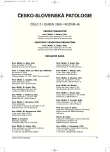Authors:
Hiroshi Kinoshita *; Hiroyuki Motomura *; Shogo Kasuda **; Minori Nishiguchi *; Kiyoshi Matsui *; Motonori Takahashi *; Harumi Ouchi *; Takako Minami *; Takehiko Yamamura *; Nao Otsu *; Shie Yoshida *; Nobuyuki Adachi *; Takehiko Ohta *; Shigeru Hishida *
Authors‘ workplace:
Department of Legal Medicine, Hyogo College of Medicine, 1-1 Mukogawa-cho, Nishinomiya, Hyogo, 663-8501, Japan
*; Department of Legal Medicine, Nara Medical University, 840 Shijocho, Kashihara, Nara, 634-8521, Japan
**
Published in:
Soud Lék., 54, 2009, No. 2, p. 16
Case history
Almost completely skeletonized human remains were discovered in a mountain area. Routine examination lead us to determine that the deceased was a male of 40–50 years of age. Inspection indicated healed fractures in the bilateral ulna and radius, right tibia and calcaneus with surgical intervention involving metal plate and screws, but no evidence of recent injury was recognized. The serial number of each of the metal plate and screws was identified (Figure 1). Based on these serial numbers, the person thought to correspond with the remains, was identified by the authorities. Superimposition of his picture showed a perfect match.

It is common to use dental findings, radiological characteristics and DNA typing for the personal identification of skeletal remains [2, 3, 5, 6]. However, such antemortem data as victim’s dental records, radiograph or DNA profile are necessary for the comparison. Discrete anatomical abnormalities such as healed fractures, prostheses, bone disease and surgical artifacts are also useful individual characteristics [6]. In the present case, there were multiple previous fractures with surgical intervention involving metal plate and screws, the serial numbers of which facilitated the positive identification. It has been reported that various kinds of implanted medical devices provide useful information [1, 4]. Implanted plate and screws can indeed provide useful information for personal identification.
All correspondence concerning this paper should be addressed to:
Dr. H. Kinoshita,
Department of Legal Medicine, Hyogo College of Medicine,
1-1, Mukogawa-cho, Nishinomiya, Hyogo, 663-8501, Japan
TEL: +81-798-45-6578
FAX: +81-798-49-3279
e-mail: kinochin@hyo-med.ac.jp
Kinoshita H et, al.
Sources
1. Aoki Y, Nata M, Hashiyada M, Saigusa K, Nakayama Y.: Five cases of positive identification by means of implanted medical equipment. Res Pract Forens Med 1998; 41: 193–198.
2. Bernstein M.: Forensic odontology. In: Eckert WG, editor. Introduction to Forensic Sciences. 2nd edition. Boca Raton: CRC press; 1997. pp. 295–342.
3. Brogdon BG.: Radiological identification of individual remains. In: Brogdon BG, editor. Forensic Radiology. Boca Raton: CRC press; 1998. pp. 149–187.
4. Isaacs TW, Margolius KA, Chester GH.: Postmortem identification by means of a recovered intraocular lens. Am J Forensic Med Pathol 1997; 18: 404–405.
5. Žscan MY, Loth SR.: The scope of forensic anthropology. In: Eckert WG, editor. Introduction to Forensic Sciences. 2nd edition. Boca Raton: CRC press; 1997. pp. 343–369.
6. Knight B.: Forensic Pathology. 2nd edition. London: Arnold; 1996. pp. 95–132.
Labels
Anatomical pathology Forensic medical examiner ToxicologyArticle was published in
Forensic Medicine

2009 Issue 2
Most read in this issue
